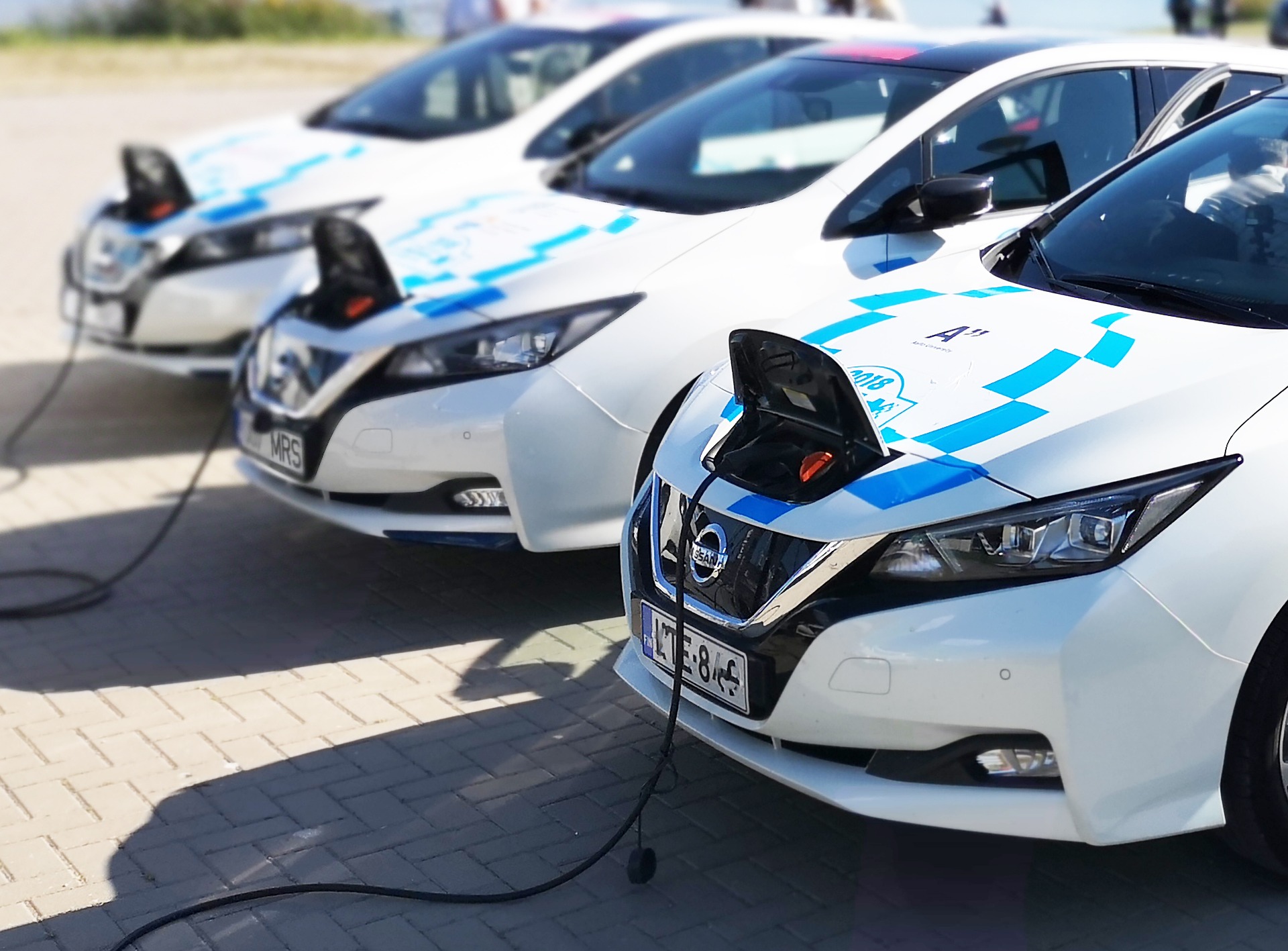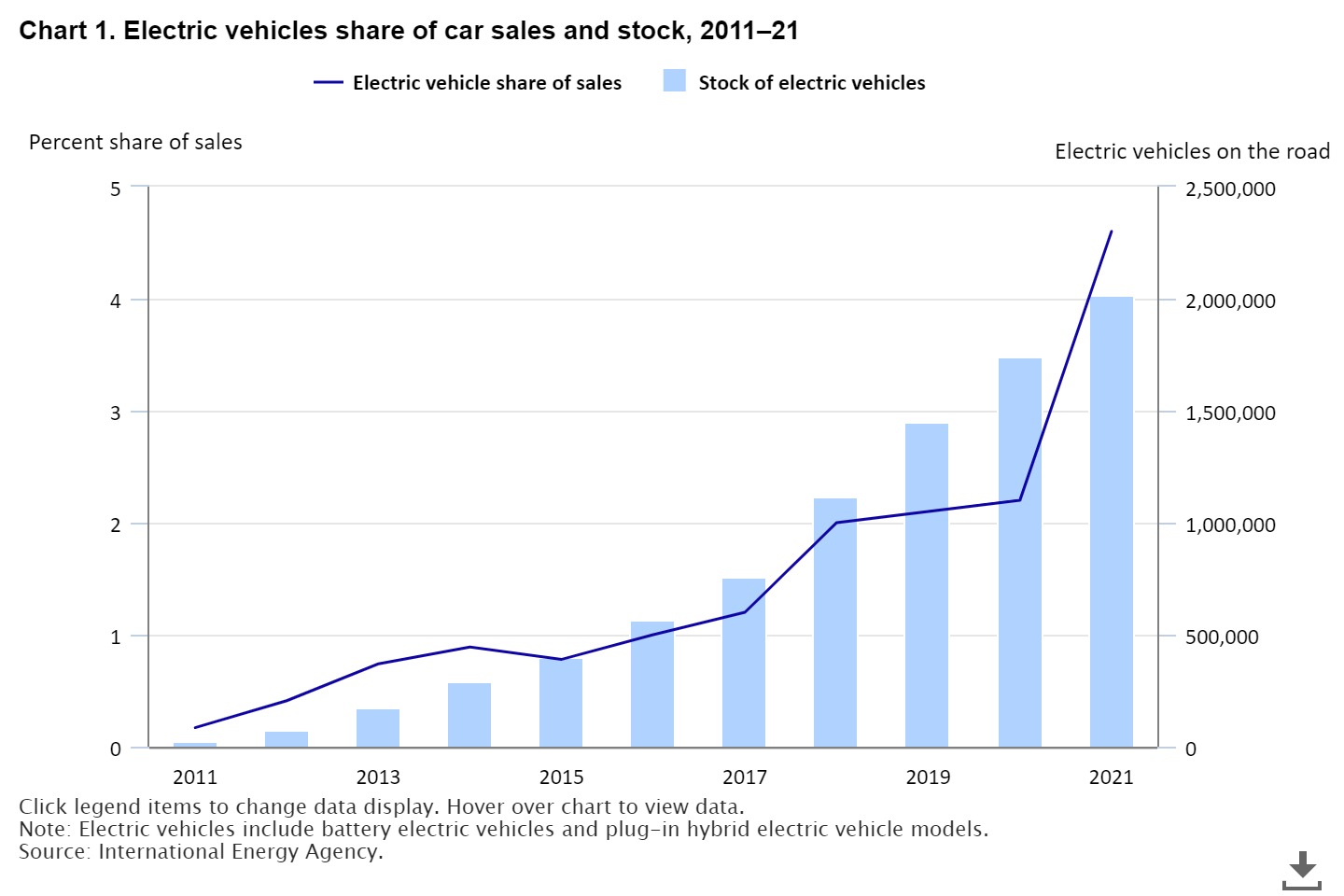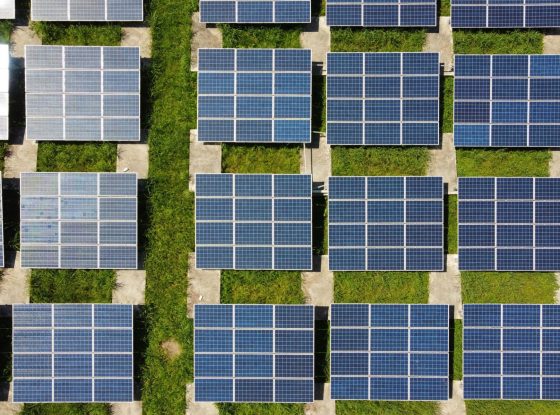Charging into the future: the transition to electric vehicles

Ready to charge into the future? The market for electric vehicles (EVs) has grown rapidly in recent years and is expected to continue to grow at a fast pace over the coming decade. Electric car sales in the United States increased from a mere 0.2 percent of total car sales in 2011 to 4.6 percent in 2021.
Although forecasts for the rate of EV adoption over the next decade vary widely given rapid changes in both government policies and the auto manufacturing industry in recent years—many forecasts expect a strong acceleration in EV adoption. S&P Global Mobility forecasts electric vehicle sales in the United States could reach 40 percent of total passenger car sales by 2030, and more optimistic projections foresee electric vehicle sales surpassing 50 percent by 2030.
This Beyond the Numbers article examines the main factors expected to contribute to growth in the electric vehicle market and identifies some occupations that are expected to play a role in the design and development of electric vehicles, in the manufacturing of the batteries that power them, and in the installation and maintenance of the infrastructure needed to charge them.
Factors contributing to a growing electric vehicle market
There are several factors contributing to the growing EV market such as increased consumer interest, government policies, and buy-in from the auto industry.
Factors driving up consumer demand
Consumer demand for EVs has risen significantly over the past few years. The number of EVs on the road jumped from about 22,000 to a little over 2 million over the 2011–21 decade.(See chart 1.) Several factors are expected to continue to drive consumer demand for EVs over the 2021–31 decade: environmental concerns, greater vehicle choice, improved battery capacity, and cost savings.

A YouGov poll of drivers shows that the top reason for considering buying an EV was to protect the environment. Similarly, a survey from CarMax found that most car owners were concerned about fuel emissions and perceived the main advantage of EVs to be that they are good for the environment.
In addition, consumers can now choose from a wider range of vehicles, as manufacturers have introduced a greater variety of EV models into the market, including the much-preferred large-size vehicles. Up until recently, compact cars like sedans and hatchbacks were virtually the only EV options available, yet trucks and SUVs accounted for about 78 percent of new vehicle sales in the United States in 2021. Choice is only set to expand, with dozens of new models expected to debut by 2024.
Improved vehicle range is another factor that should encourage higher uptake of EVs. Range anxiety—the fear of running out of battery power before reaching a charging location—has long deterred consumers from purchasing an EV. However, battery capacity and range have greatly improved (from a median of 68 miles on a single charge in 2011 to 234 miles in 2021) and is expected to continue to increase with further advances in battery technology.
Furthermore, studies have found that switching to EVs saves consumers money, especially over the long run. For example, in addition to saving on fueling costs, EVs yield about $8,000 to $12,000 worth of savings on maintenance over the lifetime of the vehicle. Moreover, battery pack costs should continue to fall, bringing EV prices closer to those of conventional cars.
Government policies driving demand for electric vehicles
The Infrastructure Investment and Jobs Act, signed into law in November 2021, allocated $7.5 billion to building out a nationwide charging network. The funding has initially focused on installing fast chargers along the interstate highway system, which would help mitigate battery range fears and enable long-distance travel. The legislation also included large investments to upgrade the nation’s power grid—key for accommodating rising electricity demand as EV adoption grows—and to expand domestic battery production and recycling capacity. On the consumer side, tax credits spur demand. For instance, the Inflation Reduction Act, signed into law in August 2022, extended a tax credit of up to $7,500 for the purchase of new EVs until 2032 and provided, for the first time, that tax credits could be used for purchasing used EVs.
State government policies also offer incentives, such as rebates, to encourage EV ownership by helping offset the high upfront costs of EVs. A number of states have also implemented a zero-emission vehicle (ZEV) program, which requires auto manufacturers to sell a set quota of battery-electric or plug-in hybrid-electric vehicles, and have passed laws that ban the sale of new gas-powered vehicles by 2035.
Automaker commitments to electric vehicles
Automakers have unveiled strategies to speed up the electrification of new cars and trucks. Most major companies plan to roll out dozens of new electric vehicle models over the next decade, are implementing electric vehicle sales targets, and committing to eventually end fuel-powered vehicle production. To achieve their electrification goals, automakers plan to invest billions of dollars over the next decade in research and development and building new manufacturing plants, particularly for battery production.
Occupations involved in the electric vehicle transition
The vehicle electrification trend is expected to generate demand for labor in three main areas: the design and development of electric vehicle models, the production of batteries that power them, and the installation and maintenance of charging infrastructure. Below is an overview of key occupations that will be involved in these activities. This is not intended to be an exhaustive list of occupations that will be impacted by the growing adoption of electric vehicles, but an overview of several important occupations that will contribute to the EV transition.
The employment projections presented for these occupations represent the total employment change for these workers across the economy. Since many of these occupations are employed by large sectors, such as manufacturing or construction, their employment outlook for the 2021─31 decade is not just influenced by the increase in electric vehicles. Other factors such as expected demand for various manufactured goods, increased automation in manufacturing, and future demand for new residential and nonresidential buildings, are likely to affect employment. Additionally, demand for occupations can vary across different industries and fields.
Occupations employed in the design and development of electric vehicles
Some of the occupations that will play pivotal roles in the design and development of electric cars are computer and engineering occupations. Computer occupations create or support computer applications and networks, while engineers design and develop structures or products. Designing an electric car may involve the contributions of several types of engineers. For example, some engineers design the mechanical parts of the car, such as the brakes or motor. Others may develop safety systems, like blind spot and collision alert systems, and the cameras and sensors that enable them. Still other engineers may specialize in electric battery technologies. Software developers and other computer occupations develop an electric car’s software and computer hardware.
All the occupations highlighted below typically require a bachelor’s degree for entry and earned wages well above the $45,760 median annual wage for all occupations in 2021. (See table 1.)
Software developers create the computer applications that run EVs such as battery management systems. EVs will become more technologically advanced over time, for example, by integrating autonomous driving capabilities, and will require more frequent over-the-air software updates and upgrades to ensure that systems are working properly and securely. As such, the expertise and skills of software developers will be increasingly needed to create the software that controls these vehicles.
Employment of software developers is projected to grow by 26.0 percent from 2021 to 2031, which is much faster than the average for all occupations. About 143,400 openings for software developers are projected each year, on average, over the decade for growth and replacement needs.
Electrical engineers develop EV electric systems and parts, including the motor. These engineers work in the generation and distribution of electricity and will be needed to research and improve the performance of vehicle power electronics, or the electrical circuitry that controls the flow of electrical energy from the battery to the motor to the other parts of the car. Electrical engineers may also work on EV battery technology or in the design and installation of charging stations.
Employment of electrical engineers is projected to grow 1.6 percent over the 2021─31 decade, slower than the average for all occupations. Despite limited employment growth, about 12,300 openings for electrical engineers are projected each year, on average, over the decade. While some of the openings are expected to result from new jobs, most will stem from the need to replace workers who transfer to different occupations or exit the labor force, such as to retire.
Electronics engineers are responsible for designing electric vehicle control systems, such as the driver infotainment system, and the electronics that enable advanced driver safety systems—such as automatic braking and collision prevention—and battery management systems. Electric cars will increasingly use new technologies, such as those that regulate and monitor battery health and performance, and those that implement driver safety systems and self-driving features. These advanced features mean more sophisticated electronics will be incorporated into new electric vehicles and automakers will need the expertise of electronics engineers to develop and test these electronic components.
Employment of electronics engineers is projected to grow 6.0 percent over the 2021─31 decade, about as fast as the average for all occupations. About 7,800 openings for electrical engineers are projected each year, on average, over the decade.
Chemical engineers design processes and equipment for large-scale manufacturing of electric vehicle batteries, plan and test production methods, and direct battery-making operations in manufacturing plants. As vehicle manufacturers ramp up EV production, chemical engineers will be in demand to develop advanced battery materials and the next generation of electric batteries that can recharge faster or can store more energy. Moreover, chemical engineers will help develop methods for recycling EV batteries.
Employment of chemical engineers is projected to grow 13.9 percent from 2021 to 2031, much faster than the average for all occupations. About 2,000 openings for chemical engineers are projected each year, on average, over the decade.
Table 1. Employment projections, 2021–31, and worker characteristics, 2021, for select electric vehicle-related occupations (employment numbers in thousands)

Occupations in battery manufacturing
As automakers produce more electric cars and trucks, new manufacturing plants will be built to meet the growing demand for electric vehicle batteries. Employment in the other electrical equipment and component manufacturing industry (NAICS 3359), which includes the production of electric vehicle batteries and battery chargers, is projected to increase 17.0 percent over the 2021−31 decade, making it one of the fastest growing manufacturing industries in the economy.
The opening of new manufacturing facilities will result in a variety of new jobs, from the production workers who assemble the batteries, to their supervisors, to the managers who oversee the financial operations of the plant. The two largest occupations employed in the industry are electrical, electronic, and electromechanical assemblers; and miscellaneous assemblers and fabricators, which include team assemblers. Combined these two occupations represented over 30 percent of industry employment in 2021. These occupations have lower educational requirements compared with other occupations related to electric vehicles—typically requiring a high school diploma or equivalent. However, additional preparation via on-the-job training is typically needed to enter each of these occupations. Workers in these occupations tended to earn less than the median annual wage for all occupations in 2021. (See table 2.)
Electrical, electronic, and electromechanical assemblers build electrical or electronic equipment, such as electric motors, batteries, and sensing equipment.
Within the other electrical equipment and component manufacturing industry, employment of electrical, electronic, and electromechanical assemblers is projected to grow 21.0 percent from 2021 to 2031. Total employment of electrical, electronic, and electromechanical assemblers is projected to grow 2.2 percent, which is slower than the average growth for all occupations. In total, about 32,800 openings for electrical, electronic, and electromechanical assemblers are projected each year, on average, over the decade.
Miscellaneous assemblers and fabricators, often referred to as team assemblers, rotate through different tasks on an assembly line, rather than specializing in a single task.
Within the other electrical equipment and component manufacturing industry, employment of miscellaneous assemblers and fabricators is projected to grow 2.8 percent from 2021 to 2031. However, total employment of miscellaneous assemblers and fabricators is projected to decline 7.1 percent. Nevertheless, about 142,700 openings for miscellaneous assemblers and fabricators are projected each year, on average, over the decade from the need to replace workers who transfer to different occupations or exit the labor force.
Table 2. Employment projections, 2021–31, and worker characteristics, 2021, for select electric vehicle-related occupations (employment numbers in thousands)

Occupations involved in charging network development and maintenance
As the number of EVs on the road increases, so too will demand for charging infrastructure. Because most EV charging takes place at home, most chargers are expected to be installed at residences. Electrical-related occupations, mainly electricians, can perform these installations. But to support the widespread adoption of EVs, a reliable and publicly available charging network will be needed. Studies indicate that at least one public charger is needed for every 10 to 15 EVs, even with drivers charging at home. Because nonresidential installations, such as fast charging stations, are often more complex, there may be other stages of project development involved, such as planning and construction work. Thus, other occupations will be needed as well. The following is a small sample of the occupations that will be responsible for deploying and supporting the nationwide buildout of EV chargers. Except for construction laborers, these occupations typically earned a much higher annual wage than the median for all occupations in 2021. And except for urban and regional planners, some form of on-the-job training is typically needed to enter these occupations. (See table 3.)
Urban and regional planners will be needed to ensure the optimal placement of charging infrastructure. Planners play a key role in determining the charging station needs in each community as well as the efficient placement of chargers across a geographical area, by considering factors such as convenience for drivers and proximity to other charging units.
Employment of urban and regional planners is projected to grow 3.8 percent from 2021 to 2031, about as fast as the average for all occupations. About 3,800 openings for urban and regional planners are projected each year, on average, over the decade.
Electricians hold an integral position in the roll-out of the EV charging infrastructure and will therefore be in demand. They are directly involved in the installation of chargers and the associated infrastructure, such as electrical wiring and fixtures, across various sites including homes, workplaces, retail locations, and along transit corridors. Electricians are also responsible for the maintenance and repair of EV charging equipment.
Employment of electricians is projected to grow 7.1 percent from 2021 to 2031, about as fast as the average for all occupations. About 79,900 openings for electricians are projected each year, on average, over the decade.
Electrical power-line installers and repairers install the lines that connect the EV charging station sites to the power grid. In addition, they may be needed to upgrade existing infrastructure or expand grid capacity to accommodate higher electricity demand from the increase in the number of EVs on the road.
Employment of electrical power-line installers and repairers is projected to grow 3.2 percent from 2021 to 2031, slower than the average for all occupations. About 11,100 openings for electrical power-line installers and repairers are projected each year, on average, over the decade.
Construction laborers are involved in site preparation work needed for the installation of wiring, conduit, and the charging units, which may require removing concrete, trenching, boring, backfilling, and repaving the surface after the installations.
Employment of construction laborers is projected to grow 5.3 percent from 2021 to 2031, as fast as the average for all occupations. About 143,200 openings for construction laborers are projected each year, on average, over the decade.
Table 3. Employment projections, 2021–31, and worker characteristics, 2021, for select electric vehicle-related occupations (employment numbers in thousands)
 The occupations highlighted in this article are not the only ones that may work on EV-related activities. For example, construction and building inspectors may be involved in the construction permitting process for certain charger installation projects while industrial engineers may plan the retooling of vehicle manufacturing plants for electric vehicle production. At the same time, some occupations may see reduced demand because of more EVs on the road. For instance, because EVs have fewer moving parts than gasoline-powered vehicles and do not require routine oil changes, demand for automotive service technicians and mechanics will be limited over the 2021–31 decade.
The occupations highlighted in this article are not the only ones that may work on EV-related activities. For example, construction and building inspectors may be involved in the construction permitting process for certain charger installation projects while industrial engineers may plan the retooling of vehicle manufacturing plants for electric vehicle production. At the same time, some occupations may see reduced demand because of more EVs on the road. For instance, because EVs have fewer moving parts than gasoline-powered vehicles and do not require routine oil changes, demand for automotive service technicians and mechanics will be limited over the 2021–31 decade.
Conclusion
Demand for EVs has grown markedly over the past decade thanks to heightened environmental concerns, greater availability of models, increased cost competitiveness with conventional gas vehicles, and improved vehicle ranges. These factors are expected to continue to drive increased adoption over the 2021–31 decade, with the wide availability of tax incentives and other government programs supporting this trend further. The EV transition will require a wide range of occupations, with this article focusing on three key areas where they will be involved.
To learn more about the occupations discussed in this article, along with hundreds of others, visit the Occupational Outlook Handbook (OOH). Each OOH profile includes detailed information about job duties, wages, job outlook, and more.
Source : bls.gov



